|
|
Yashica - 8 - T2 1961
The camera is Japanese made by Yashima Optical Ind. Co., Ltd. On the English market it arrived in 1961. This model is named 8-T2 - two lens D-mount turret.
In July 1958, the first time the camera was shown, at the world’s largest exhibition, Photokina, held in Cologne, Germany. At that exhibition the new cine apparatus were exhibited for the first time.
Two 8 mm Yashica cameras were exposed: model - 8S (single lens), and model -8T2.
Features:
Construction and finish: the body is of die-cast light alloy construction with ribbed sides, and two-tone gray finish. Exterior and interior fittings are bright and satin chromed. The door is hinged at the back. On the door is chrome tablet with pictorial exposure guide for colour (10 ASA) and monochrome (40 ASA) film. Picture 1
A standard British tripod bush is fitted (¼ in.)
Type of loading: the gate is hinged on the inside and opens only a little way. In this way the gate and aperture are not easy to clean. Double 8 film, on usual spool, carrying 25 ft of film - the film must be turning over and rethreading.
Transit mechanism: The pressure plate is sprung to open automatically for loading; when the camera door is closed, a shaped spring closes the gate and holds it under tension. Another flat spring edge guides the film through a slot in the side of the pressure plate, while the inner edge of the film is located by fixed guides in the form of two chromed strips.
The claw is of the sprung, non-slip type engaging the film through the back, one frame below the bottom of the gate; it is automatically withdrawn when the gate opens, thus simplifying loading.
The film path includes two relieved rollers in the loop above the gate; below a rubber covering post (Picture 2 -red post) helps to isolate the gate from the pull of the take up spool. The spool is the usual type driving through a slipping clutch. The clutch is adjusted so that take up occurs only with the assistance of the claw. The upper spool spindle is plain, and the lower has four dogs to engage the take up spool slots. Picture 2 & 3
Footage counter: as a scale appearing under under a magnifier. It is placed in the rear wall of the camera. The scale in our camera is calibrated in feet with start “S” and end “O” marks. The counter resets automatically to “S” when the door is opened.
Motor and mechanism: The motor is wound. The ten turns needed for a full wind are sufficient to transport about 6½ ft. of film, The motor is controlled by the usual centrifugal governor, which can be adjusted to any speed between 8 and 64 frames per second by a dial at the side of the camera.
Speeds: 8, 12, 16, 24, 32, 48, and 64 f.p.s. picture 4
Starter button: The release button is placed at the front of the right hand side of the camera and takes a standard cable release. Associated with the button is a sliding latch, giving continuous running at “R” and at “L” locking the release button for security. A small cable- release socket labeled “1” (over the release button), is used for exposing single frame. Picture 4 & 5
Viewfinder: The zoom-type viewfinder covers lenses from 6,5 - 38 mm (Picture 4 -top scale), with click-stops at the intermediate 13 and 25 mm positions. Additionally are marking to adapt the field of view to the scope wide screen attachment for 13, 25 and 38 mm lenses, though a mask has to be added to the finder to blank off the excess height.
Lenses: The swing turret, carrying two standard D mounts, is firmly held in position by a spring pin. The turret can be turn clockwise and anti clockwise rotation.
Both lenses in our camera are produced by Yashica Cine Yasinon:
- f = 38 mm; 1:1,4; No prod 810535
- f = 13 mm; 1: 1,4; No prod 824126
Both lenses are bloomed on all surfaces.
Dimensions of the camera: The camera measures 6 x 2 x 3 ½ in. over the body, and weights about 2 lb.
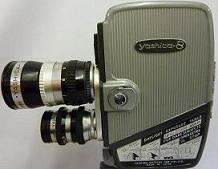 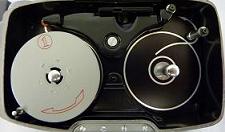 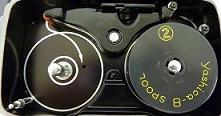
Picture 1 Picture 2 Picture 3
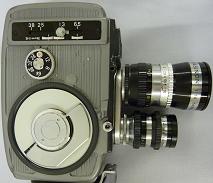 Picture 5 Picture 5
Serial production No 5862614
Description based on the ACW: March 1961; and July 1958 editions.
|
Picture 4
Picture 6 |
|
|
|
|
|
|
Canon Zoom Reflex 8 - August 1959
The camera is Japanese made by Canon Camera Co. Inc.
Features:
Construction and finish: the body is of die-cast light alloy construction. The camera is consists of three parts: the motor mechanism and film chamber - in light greenish-gray colour; the lens tube; the top part with exposure meter dial and meter window- in dark colour.
Type of loading: The camera takes standard 25 ft (7 1/2 meters) spools of double 8 mm film. Half of this width is exposed on the first run-through. The film spools are then reversed, turning them upside down and replacing them exchanging their position. The remaining half can be exposed as the same film is used for the second time. It should be done in a dark room.
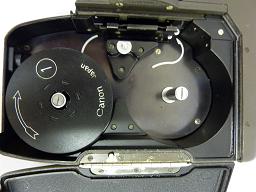 Pict. 1; The film chamber with the take-up spool Pict. 1; The film chamber with the take-up spool
Transit mechanism: The film is transported through the gate by a claw work. When the film is correctly in place - the loop of film over the film gate and placed the taken-up spool on the take-up spindle, closing the side cover the film gate is automatically in position for the film to pass through.
Footage counter: The footage scale is on the rear wall of the camera. The footage counter indicator dial automatically returns to “S” (starting position) as the side cover is opened; to keep the same footage it have to press the footage counter control button. After completion of the film loading it has to be pressed the exposure lever until the figure “S” on the footage counter moves to indicate “0”. When the film runs out the letter “F” is visible in the footage counter.
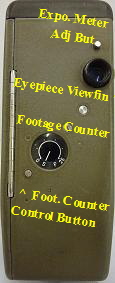 Pict. 2; Exposure Meter Adjustment Button;Viewfinder eyepiece; Footage counter scale control button Pict. 2; Exposure Meter Adjustment Button;Viewfinder eyepiece; Footage counter scale control button
Motor and mechanism: The camera uses the spring motor, clockwork mechanism. One winding of the motor allows to expose approximately 600 frames (2.3 m) of film. A warning signal sounds circa 3 seconds before the motor runs down.
Speeds: 8, 12, 16, 24, 32, 48, and 64 f.p.s.; a single frame exposure is also possible. (Pict 3 - over the key winding)
Starter button: The release button is placed at the front of the right hand side of the camera and takes a standard cable release. The exposure lever is equipped with a safety lock and a running lock (the wheel visible in Pict. 4) which enables continuous picture taking without having the exposure lever kept depressed. ( Pict 4; ) To unlock, the locking ring has to be rotate back until the red mark is concealed.
 Pict 4; the release button and safety locks Pict 4; the release button and safety locks
Exposure control: The camera has fully automatic exposure control system with a built in exposure meter, which is coupled to the lens aperture. (Pict. 3 - over the lens meter window)
 Pict 5; Exposure meter Pict 5; Exposure meter
Lens: The Canon Zoom lens C-8; No 30128; with zooming range 10 -40 mm; f 1.4;
Viewfinder: The range-viewfinder is built in this camera. Looking through the eyepiece, it is seeing a thin line running across the viewfinder; the image is split in halves when out of focus, This is called the split-image Range-Viewfinder. The split image rangefinder gives critical focusing. It is free from parallax errors; the aperture diaphragm does not appear in the way. The viewfinder is fitted with an eyepieces lens suitable for normal eyesight and for those with defective vision. Rotating the hood on the eyepiece, it is possible to adjust for the viewer vision.
Dimensions of the camera: The camera measures: W 57 x H 137 x D 193 mm; and weights 1200 g without the pistol grip.
Available accessories to this model: Wrist strap, trigger grip with the pouch, and Leather carrying case ; -these accessories are included with our camera. Additional accessories available: 48 mm filters screw in the lens.

Serial production No 70015
|
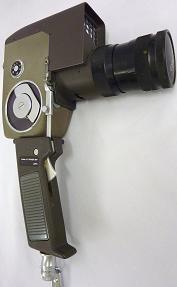
Pict. 3
|
|
|
|
|
|
|
Canon Zoom Reflex 8-2 - 1961
The camera is Japanese made by Canon Camera Co. Inc. It was announced in November 1961, in Amateur Cine World, as a new camera on the market. The description, in ACW, stated: “First details have just been released of the new Canon Reflex Zoom 8-2. In appearance it is very similar to the present model though the pistol grip is more compact and sturdy looking. The specification is also similar but one important refinement is the built-in cadmium Sulphide exposure meter with viewfinder match the needle control. The Canon Zoom 8-2 will be available on the British market as soon as the import restriction permit. The price will be £96 2s. 10d.”
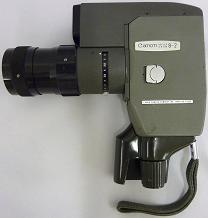 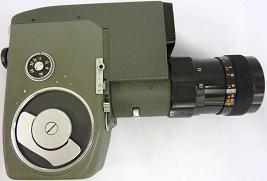
Pict 1 The camera Canon Zoom Reflex 8 -2 - both sides
Different Features to the model Cannon Zoom Reflex 8:
Construction and finish: is exactly the same as model Canon Zoom Reflex 8. It is finished in two gray colours.
Exposure control: The camera has the exposure meter is powered by one 1.3 V M-P or RM-1(USA) mercury cell located above the viewfinder (Pict. 2 & 3). To set the exposure the aperture control knob must be rotated to set the needle visible in the viewfinder, on top of the central “V” mark. A high sensitivity cadmium Sulphide exposure meter (Pict. 4) is coupled to the lens iris to give Semi-automatic exposure control.
Lens: The Canon Zoom lens C-8 with zooming range 10 - 40 mm; f 1.4; No 143159
Viewfinder: The viewfinder built in this camera is slightly different. The hood on the eyepiece is bigger and it easy to adjust the focus diopter - 3 to + 2. Viewing and focusing is carried out by means of the through the lens reflex system which includes a split image rangefinder.
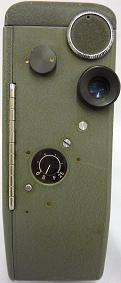 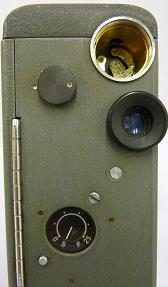
Pict 2 & 3; footage counter; eyepiece viewfinder; the compartment for the battery
Available accessories to this model: Our camera has the wrist strip and pistol grip, visible in the Picture 1; Additional accessories available to this model: haze filters screw in the lens; carrying case
The Canon Zoom Reflex 8 and model 8-2 were very high quality cameras at the time, compared with other cheep Japanese cameras. The lenses are high quality. The aperture of the lenses are large at that time.
Serial production No 177020
|
Pict 4; cadmium Sulphide exposure meter |
|
|
|
|
|
|
Cine Canonet 8 - 1963
The camera is Japanese made by Canon Camera Co. Inc. It is slim, long and a very elegant camera. It is electric drive camera.
Features:
Construction and finish: the body is of die-cast. The camera is finished in fine black wrinkle, completed with satin chrome on the front cover, and on the lens and photocell mountings. The door is hinged to the front of the body, it opens very widely, in this way accessibility for film threading is very good. On the top of the camera is the batteries and reflex viewfinder tube (Picture 1).
Type of loading: The camera takes standard 25 ft spools of double 8 mm film. The film path is marked on the back plate from FULL SPOOL to the top of the gate. The post after the gate is covered with rubber.(Picture 2). The very clear instruction is placed on the back door. (picture 1)
Transit mechanism: The film is transported through the gate by a claw working with a ratchet action - driven up and down, sprung into the film perforation for the down stroke, and sliding back up over the film on the up stroke. The claw starts the pull down three frames below the bottom of the gate aperture.
Footage counter: The footage scale is in the side of the camera. The pointer is worked from a sprung arm in the film chamber. The scaling of the footage indicator starts at S (start), then 0-5-10-15-20-25 and F (finish). (Picture 3- left side).
Motor and mechanism: The camera uses electric motor drive. It is powered by three penlight batteries 1½ - volt each. The motor consumption is about 130 mA during normal running and 140 mA when switched to 24 f.p.s.
Speeds: three running speeds are provided 12;16 (normal); and 24 f.p.s.
Starter button: The starting button is on the side of the camera, near the front, and is pressed to run the camera.(Picture 3) Around the button is the three position switch: ON; OF; REMOTE. For normal running the switch is ON. The camera is running either by the starting button, or by using a cable release in the RUN socket. Single frame can be taken by moving the cable into the next socket (marked 1). The camera can be set running by using REMOTE switch, available as an accessories. This consists of a precise little plastic switch box with coaxial cable, and a moulded-on coaxial 3 mm plug on the end. The plug fits into the little socket in the side of the camera (Picture 3-left bottom socket).
Exposure control: The camera has fully automatic exposure control system with a twin iris operated by the meter movement. The system is worked by the power from 1.35 volt mercury battery (Toshiba TH-MP or English- Mallory PX-1) (Picture 4-left top holder) , and controlled by the Cadmium Sulphide photoconductive cell on the front of the camera. (Picture 5) In front of the cell is an iris which is worked by the emulsion speed setting ring - the amount of light is set according to the emulsion speed of the film being used - from 10 to 320 ASA, and from 11 t0 26 DIN. The emulsion speed is set against the index mark for the appropriate running speed - 12, 16, 24 fps. The f number is indicated by the meter needle, which is seen in the top of the viewfinder. It is possible to set for automatic or manual adjustment. The front small knob - picture 5
The camera has a control system of the batteries power. By the footage meter is indicator of the batteries strength. It is possible to make a test of the batteries, pushing a tiny red button, in the base of the camera. The meter reads - blue good power; red - bad and between them, on white area - batteries have enough power to run at 16 fps but not enough for 24 fps.
Lens: The Canon Zoom lens C-8 with zooming range 10 -25 mm; 1:1.8. The lens was specially produced for this camera and designated Canon type C-8. It is multicoated lens. The focusing scale is in meters from 1.2 - black numbers and feet from 4 ft - green.
The lens has an internal thread for colour filter.
Viewfinder: The reflex viewfinder is built in this camera. The eyepiece lens, in the back of the camera has a 13 magnification and is bloomed. The eyepiece can be adjust to the different eyesight, by a small ring inside the top cover.
Dimensions of the camera: The camera measures: 7¾ in L x 3⅜ in H x 1⅜ in Thickness, and weights about 2½ lb.
Available accessories to this model: foldaway carrying case; pistol grip; wrist strap; remote control unit and filters: Skylight, Amber, Blue and Neutral. A close up lens made for this camera. These accessories are not included, with our camera.
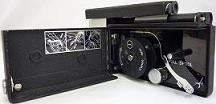 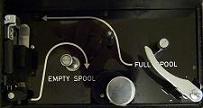 
Picture 1 Picture 2 Picture 3
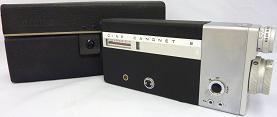 - the camera with the original Canon case - the camera with the original Canon case
Serial production No 139632
Description based on the ACW: February 1964 and “Photography Directory and Buying Guide” 1965 edition.
|
Picture 4
Picture 5 |
|
|
|
|
|
|
Cine - Kodak Eight Model 20 - 1932
The camera is made by Eastman Kodak Co., Rochester, N.Y., USA. It was introduced to the market in 1932. It was the first 8 mm amateur movie camera.
Features:
Construction and finish: the metal body is partly covered with black grained leatherette. A metal strap covered with black enamel with silver flex) is built between the two sides. The camera’s interior is covered in the same enamel with silver flex. In the bottom of the camera is built in a tripod bush with 1/4 inch width thread.
Type of loading: The camera takes standard 25 ft spools of double 8 mm film. It takes 16 mm film with 8 mm perforation. After the film run one side, it has to be turn over and run the other side. After processing the film was split lengthwise and spliced giving 50 ft of 8 mm width film, with projection time of 4 minutes and 10 seconds. The film path is marked on the back plate from FULL SPOOL to the top of the gate. The spring of the motor must be in side of the large sprocket. (Picture 3 & 4)
Transit mechanism: The film is transported through the gate by a claw.
Footage counter: The footage scale is connected to the swinging arm, which rests on the film on the supply spool. (Picture 2 & 1 Model 60)
Motor and mechanism: The camera uses the spring motor, clockwork mechanism.
Speeds: Single speed - 16 fps.
Starter button: The starting button is on the side of the camera (Picture 2 & 1 Model 60) When button is pushed into the first position the motor runs, in the further depressing the button downwards, it is continuous running.
Exposure guide; the camera has a built in exposure guide underneath the lens aperture, on the front plate for a Kodak b/w film (Picture 5).
Lens: The camera is fitted with Anastigmat 13 mm f-3.5 lens. The lens is manually adjustable to five different light settings.(Picture 5).
Viewfinder: The optical parallax viewfinder combined with carrying handle is built in the camera. (Picture 1 & 2)
Dimensions of the camera: The camera measures: 4 ¾" x 6 ½" x 1 ½". Weight; 1012 g (2.37 lb)
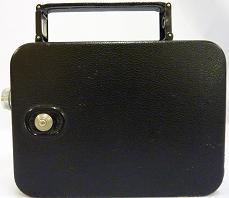 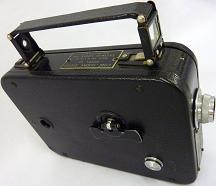
Picture 1 Picture 2
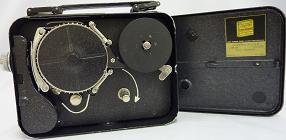 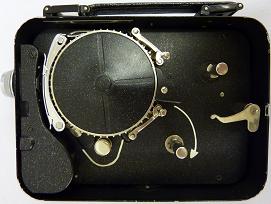
Picture 3 Picture 4
Serial production No 8449
|
Picture 5 |
|
|
|
|
|
|
Cine - Kodak Eight Model 60 de Lux - ca 1936
The camera is made by Eastman Kodak Co., Rochester, N.Y., USA. This model was manufactured after 1936. That indicated the Kodachrome film mark placed on the camera cover. The Kodachrome film was not produced before 1936.
Features:
Construction and finish: the metal body is fully covered with black grained leatherette, completed with chrome metal parts. It is more luxury construction. The film house is completed with engine turn finished. In the bottom of the camera is built in a tripod bush with 1/4 inch width thread.
Type of loading: is the same as the above camera - Model 20.
Transit mechanism: The film is transported through the gate by a claw, like in the Model 20.
Footage counter: The footage scale is connected to the swinging arm, which rests on the film on the supply spool. (Picture 1- left round window )
Motor and mechanism: The camera uses the spring motor, clockwork mechanism.
Speeds: Single speed - 16 fps.
Starter button: The starting button is on the side of the camera (Picture 1 - right corner) Mechanism is working in the same way as Model 20.
Exposure guide; the camera has a built in exposure guide underneath the lens aperture, on the front plate for a Kodak b/w film (Picture 4).
Lens: The camera is fitted with Kodak Anastigmat f-1.9 13 mm focusing lens. The lens is interchangeable with f 4.5 1 1/2” telephoto lens (Picture 5)
Viewfinder: The optical parallax viewfinder combined with carrying handle is built in the camera. (Picture 4 & 5)
Dimensions of the camera: The camera measures: 4 ¾" x 6 ½" x 1 ½". Weight: 1118 g (2.74 lb) This model is a little heavier then Model 20 because of the weight of the lens.
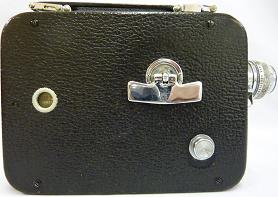 
Picture 1 Picture 2
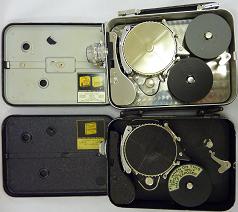
Picture 3 - the top camera - Model 60; below Model 20
Serial production No C 2749
|
Picture 4
Picture 5 |
|
|
|
|
|
|
Pathe DS8/BTL Double Super 8 Professional Reflex
The camera was produced in France by Pathe. The previous model was Pathe DS8/BTL which was taken only double super 8 mm spool of 30 m. It was on the market in 1965-1966.
This model - Pathe DS8/BTL Double Super 8 Professional Reflex, was announced at 17 October 1965, in The New York Times - “A 100-foot double Super 8 film spool and the camera to take it were introduced last week by Pathe Products, Inc. The camera is the Pathe professional Reflex DS8/BTL, and the film is Kodachrome II (daylight and Type A) in reversible spools containing 100 feet of Super 8 film” . http://www.nytimes.com/; http://query.nytimes.com/gst/abstract.html?res=9903EFDD1F30E23ABC4F52DFB667838E679EDE
The camera was presented at annual new cine equipment “Photokina 66 cameras” exhibition, in December 1966; a report was published in “8 mm magazine” January 1967 edition (in our collection) - Pathe had a double-super 8 100 ft spool - loading version of the Webo Reflex, the DS8/BTL for research and similar application, with triple turret, reflex viewfinder, auto treading, spring drive for 8 -80 fps, backwind, variable shutter and semi auto TTL [TTL -Through the lens] exposure meter for 12-400 ASA films. Numerous accessories are available [...] electric motors, external 200 and 400 ft double run magazines (think of it - 20 mins uninterrupted run at sound speed before the roll is turned over for the second run!)
The camera accepts both magazines - 200 and 400 ft (30 m and 120 m), day-light loading reels. The magazine is fitted with: footage counters (meters and feet); 6 Volt motor; steel battery can be used for field work where mains supply is not available; controlled speed; 8-80 pictures per second; tachometer.
The name of the camera has an abbreviation - BTL. It does mean - Behind The Lens. In the leaflet - “3 Pathe Webo At/BTL 1” ca 1967 (in our collection Pict below) is an additional explanation:
“ Behind the lens (BTL) reflex cell , analyzing the light received by the film through all the lenses from wide-angle to telephoto for all running speeds of the camera, for all lenses openings, any variable shutter position, [with all emulsions used] any ASA setting from 12 to 400, with any filter, and all the accessories, before or behind the lens”
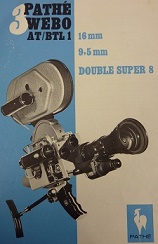 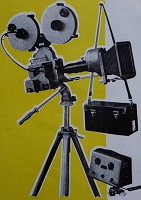 accessories - French Catalogue EPC accessories - French Catalogue EPC
The camera was very expensive in the English market. In 1968 it was priced £394, when at that time the average salary was £25-30 per week.
Features:
Our camera is missing the spring motor winding handle, rubber eyepiece of reflex viewfinder, lenses and does not have any accessories - cassettes, arm’s holder and the electric motor Pict 1. The camera has the detachable pistol grip with EPC logo.
Construction and finish:
In the leaflet pictured above we are reading: “Strong, functional, compact, perfectly balanced, it offers in particular: a light alloy, indestructable case, molded in hydronalium [metal] A flat bottom giving great ease in general and absolutely safe for tripod attachment [tripod mount 1/4”] . Perfectly operational from -40C to +120C”.
The camera body is finished in gray hammer paint.
Type of loading and Transit mechanism:
The camera has to be opened is a special way. Release the cover lock (Pathe cock button) by pulling it up and rotating it clockwise until the feet of the Pathe Cock are pointing towards the lens.
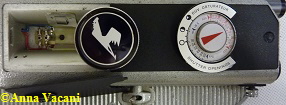
Pict 2; the battery (ZM 1)compartment for exposure meter; Pathe Cock button; exposure meter.
It is the camera with automatic film threading. Removable automatic film threading trimming the film (built in at the bottom, inside of the camera) , but possibly to work in manual threading, if you prefer.
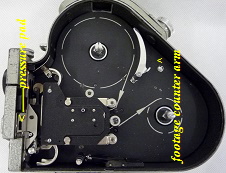 Pict 3; Loading the camera; ©Anna Vacani Pict 3; Loading the camera; ©Anna Vacani
The film speed can be manually selected between 12 and 400 ASA. ASA settings: 12, 16, 20, 25, 32, 40, 50, 64, 80, 100, 125, 160, 200, 250, 320, 400, it can be adjust on the exposure meter (Pict 2).
Mechanical Operation:
- Footage counter:
The Pathe DS8/BTL Double Super 8 Professional Reflex camera is equipped with two different counters - a frame counter (forward operation & in revers) and a film footage counter (Pict 2). When 400 foot magazines are used, the separate counters of each magazine take over. If the film is completely exposed the counter will read “0”, and when there is no film the camera the counter will read “EMPTY”.
 00 00
Pict 4; Camera’s counters & speed & selector switch - shutter release & hand cranking
- Motor and mechanism:
The camera uses the spring motor, clockwork mechanism. As you see, in the Pict 4, the winding handle is missing on our camera, it is only visible the arrow of the winding direction. While the motor spring is fully winded a bell is heard. The bell warning signal will be heard if approximately 9 feet of film have been unwound after the last complete winding. Should it be necessary to shoot a continuous scene longer that 22 feet (894 frames), either of 2 electric drive motors is recommended, by Pathe.
Either the motor may be operated directly from batteries or from AC with a transformer. The camera is equipped with one to one shaft drive for the application of many accessories: single frame motor for animation titling, synchronous drive motor, time laps motor, etc. (Pict 4 & 5)
 Pict 5; The motor drive shaft opened. Pict 5; The motor drive shaft opened.
- Selector switch
The filming selector switch and the shutter release are key controls in operating the camera. The selector Pict 4 is marked with 4 characters:
C - Continuos filming. I - Instant single frame exposure. B - Single frame time exposure. Each frame is exposed from the moment the shutter release is pressed until the moment it is let up. Variable shutter must be wide open. OFF - Safe position. The shutter release is locked, and any possibility of accidental exposure is eliminated.
To set the selector switch to any of the characters, pressing it down, turn to the desired character opposite the red triangle, on the index plate, and let it up.
- Speeds:
Filming speed: 8, 16,24,32,64,80 fps and single frame (Pict 4). To set a particular filming speed, first release the speed lock (a small black button at the camera speed index) by turning it counter-clockwise and turn speed control in either direction so that the desired speed is opposite the index mark (a small metal button, over the black one).
- Hand cranking:
The driving handle may be used to drive the film forward or backward by hand. To hand crank the film forward for special effects, first be sure that the spring motor is completely unwound and set the shutter release in continuous filming position (C). Set the film speed control at the desired filming speed. Lift the driving handle, engage it on the drive spindle and wind it as fast as possible or until you feel the definite resistance of the motor governor.
To rewind the film by hand (with the motor spring being wound up) first close the variable shutter (Pict 1a - the bottom plate - shutter control lever). Then engage the driving handle on the head of the drive spindle. Without releasing the handle, press the shutter release and wind the handle clockwise. The frame counter will record the frames rewound; in additional, each complete turn of the small handle is 8 frames.
- Variable shutter:
It is 180° (open), 135° (1/4 closed), 90° (1/2 closed), 45° (3/4 closed) and closed variable shutter, it gives you a means of controlling the exposure time that is independent of the filming speed. When used in conjunction with the filming speed control, however, it permits choosing from a wide range of diaphragm openings under almost any lighting condition. The variable shutter is also an essential control in reducing depth of field, filming fast moving objects, filming in very bright light, and making fades and lap dissolves.
To prevent accidental wasting of film a warning buzzer sounds when the shutter is completely close. The control lever may be moved while filming, may be locked in any one of the five positions, or may be left in any intermediate position.
Optical Operation:
-Lens and the lens turret:
It is C mount triple turret with interchangeable lenses. Any C mount lens with a thread length of 3.8 mm or less can be screwed on the turret of the camera. The turret lock screw is placed over the turret (Pict 1a).
- Viewfinder:
It is the reflex viewfinder. It is easy adjustable to your individual eyesight, moving the eyepiece forward or backward.
One of the key features of the reflex viewfinder is a thin glass plate with parallel faces, that is placed at an angle 45° on the optical axis between the lens and the film.
The Pathe Reflex system has no flicker. Viewing is continuous. The image is reflected directly behind the lens before it passes through the shutter.
Dimensions of the camera:
The camera measures: body dimensions 110 x 180 x 240 mm; weight 2700 gram.
The camera production number: 95220
|
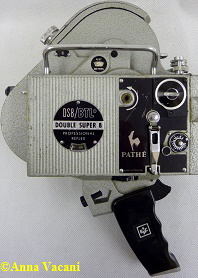
Pict 1; the side of the camera;
©Anna Vacani
Pict 1a; the front & side of the camera;
|
|
|
|
|
|
|
Page Back (1) (2) (3) (4) (4a) (5)
|
|
|